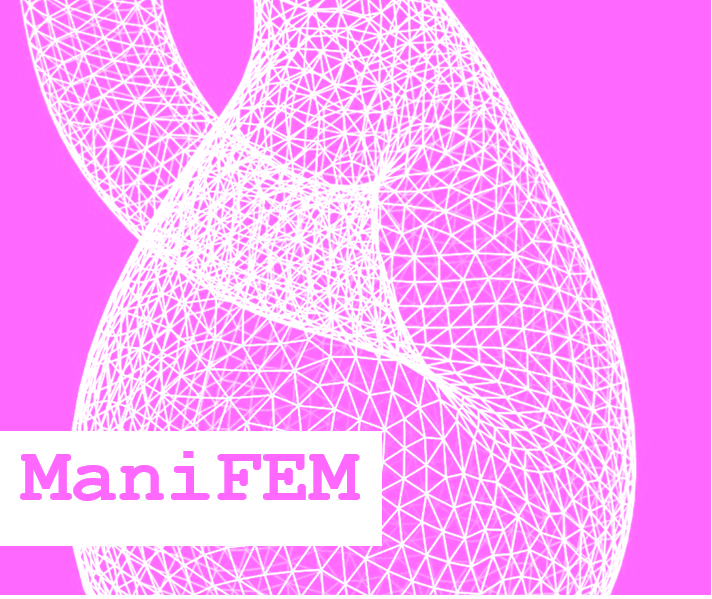

This is a mirror of the home page of maniFEM, a C++ library for solving partial differential equations through the finite element method. The name comes from "finite elements on manifolds". ManiFEM was designed with the goal of coping with very general meshes, in particular meshes on Riemannian manifolds, including quotient manifolds like the flat torus. Although most constructors build two- or three-dimensional meshes, the internal implementation of cells and meshes allows for any topological dimension. ManiFEM was written with the goal of being conceptually clear and easy to read. We hope it will prove particularly useful for people who want a fine control over the mesh, e.g. for implementing their own meshing or remeshing algorithms.
ManiFEM is just a collection of C++ classes. It has no user-friendly interface nor graphic capabilities. The user should have some understanding of programming and of C++. However, maniFEM can be used at a basic level by people with no deep knowledge of C++. Have a look at the gallery. Similar products (competitors), as well as strong and weak points of maniFEM, are listed in the manual, at the end of section 1.
In its current version, release 24.03, maniFEM works well for mesh generation,
including meshes on quotient manifolds.
The user can control variations in the element size; anisotropic meshes can also be built.
Lagrange finite elements of degree one and two are implemented for triangular
and quadrangular cells; many other types of finite elements are still to be implemented.
In the future, variational formulations will be implemented as C++ objects,
thus allowing for compact and elegant code.
A changelog is included at the end of the manual, just before the index.
To check which version of maniFEM is installed in your computer, see at the beginning of the file
maniFEM.h.
ManiFEM is written by Cristian Barbarosie and Anca-Maria Toader; see also the list of contributors and the colophon.
To learn maniFEM, you should read the manual (version 24.03). Older versions of the manual : first edition (ISBN 978-972-8394-30-1).
To use maniFEM, you should
choose a release, download and unpack the source code to some directory in your computer.
Current code
may be unstable, releases are stable.
To check which version of maniFEM is installed in your computer, see at the beginning of the file
maniFEM.h.
You can then run the examples in the manual :
just make run-parag-1.1 for the example in paragraph 1.1,
make run-parag-2.6 for the example in paragraph 2.6, and so on.
Paragraph 11.14 in the manual gives more details.
You will need a recent C++ compiler (we use g++) and the make utility.
Under linux it should be easy to install them.
It is not that easy to install and use them under Windows, but it is certainly possible,
for instance by using cygwin.
Some examples require
the Eigen library;
just copy its source tree somewhere in your computer and be sure that path
is mentioned in your Makefile under the -I flag of your compiler.
You may want to use gmsh for visualization purposes.
This work is supported by national funding from FCT - Fundação para a Ciência e a Tecnologia (Portugal), through Faculdade de Ciências da Universidade de Lisboa and Centro de Matemática, Aplicações Fundamentais e Investigação Operacional, project UIDB/04561/2020.
ManiFEM is free software; it is copyrighted by Cristian Barbarosie cristian.barbarosie@gmail.com under the GNU Lesser General Public License.
Cristian Barbarosie is Assistant Professor at Faculdade de Ciências da Universidade de Lisboa, where this web page is hosted.